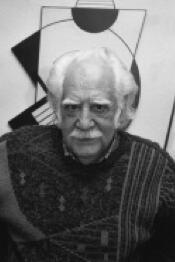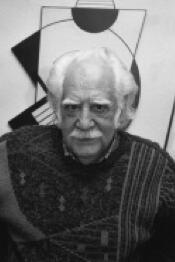IN MEMORIAM : Carmelo Arden Quin
The death of master painter Carmelo Arden Quin constitutes a great loss for Latin American art, and above all, for the diffusion of this art in Europe. A precursor and an indisputable protagonist of the Geometric-Constructivist avant garde movement in the Río de la Plata region, Arden Quin − Rivera, Uruguay, 1913 was certainly one of the great contemporary painters whose trajectory, of a remarkable richness, contributed a plethora of innovations in the field of geometric abstraction, defending an absolute freedom both in terms of materials and techniques.

I remember with great emotion my first meeting with the master, two decades ago, one spring night in the south of France, at the house of my father-in-law, poet Yvan Avena, who had known Arden Quin since the 1950s. The doorbell rang and my whole body became paralyzed; in a few seconds, everything I knew about Arden Quin and the MADI movement came to my mind; images and words intertwined: dialectic materialism, invent, trimmed frame, forme galbée, coplanars... his figure, which automatically evokes the co-founder, principal creator and constant source of inspiration of the Madi movement 1946. His friendship with his neighbor, the Catalonian writer José Sanz, led him to discover Cubism, whose teachings are reflected in his paintings dated 1934-35, and in the publication of the only issue of Arturo magazine. In 1948, after the split of the MADI group, he was the main artificer in Europe of the International Madi Movement, based in Paris, which was the axis around which all creative intentions and attempts at exhibiting revolved. The year 1950 witnessed his White Period, influenced by the aesthetic theories of Georges Vantongerloo and Michel Seuphor, whom he frequented assiduously. But, what was I to say to him? Perhaps, I thought, I should begin by commenting that my admiration dated back to the days when I was an art history student in Argentina: that was the first time I heard about an intrepid group of enterprising young artists who, in the 1940s, as a response to the country’s impoverished artistic situation and with the intention of bringing about a complete renovation of the visual arts, had created MADI. “...by creating form, MADI gave the visual arts access to a complete freedom. To achieve perpetual movement through the utilization of simple colors, polygonal structures and empty spaces. MADI is not satisfied with motionless forms and closed spaces; its concept does not consider the existence of interior and exterior; it rejects any notion of delimitation; it is a revision of the visual arts in general...”. In the end, despite the emotion I experienced in the presence of this personage with an impressive appearance, opulent white hair and an intense gaze, everything turned out to be simpler than I had imagined. I recall we talked at length about his trajectory, about MADI, about his poetry; a very fruitful exchange, which marked the beginning of a long friendship, thanks to his inherent generosity.
Without any apparent leaps or fractures, his works followed hisline of thinking with absolute consistency; a geometry-based non-figurative art originating in the intention of giving a new shape to abstraction, a less rigid development than that of con- crete art, and with a more lyrical vision. Joaquín Torres-García, with his articulated toys composed by interchangeable pieces, and the theoretical and formal implications of his tenets exerted a key influence on Arden Quin’s aesthetic theory and artistic practice.
His itinerary, which is difficult to circunscribe, is a consequence of his multiple talent, especially because he never ceased to evolve and investigate through his creations. In his most recent works, the principle of open polygonality continued to be one of the basic pillars of his artistic production and he evidently had the capacity to appropriate the necessary aesthetic and techno- logical resources that would allow him to articulate and put his ideas and his command of techniques into practice. This concept was enriched by the incorporation of new materials metal, Plexiglas, transparent plastic, buttons and chromium-plat- ed caps, small colored crystal balls, aluminum and of new visual textures, of a glossy and steely appearance.
Arden Quin will remain one of the most important referents of Latin American art and of the Rio de la Plata region art history. His temperament, his resolute character, his political conviction in 1936 he fought against fascism in Spain and he became a member of the International Brigade in Montevideo. That same year he showed his work for the first time at the Casa de España, in the framework of an event to express solidarity with the Spanish Republic and his unyielding, and sometimes aggressive defence of his ideology and his ideas, rendered him a conspicuous and controversial personage in the world of art and literature. Notwithstanding this, his passion for and his ded- ication to art, as well as his work in this field, have always been unanimously admired.
Arden Quin’s legacy is evident. In its half a century of existence, the MADI movement has not only endured but it has been in a process of constant diffusion and renovation, “...because just like today’s MADI is not the MADI of the 1950s, and the one of the 1950s is not the primitive MADI, the current MADI incorporates modern technique, light, aluminum and plastic. MADI works without any limits, just like angles or numbers, which have no limits; a picture contains a number of angles that permit an abso- lute freedom of creation. What I always ask of critics and historians is that when they refer to MADI they highlight its origin, which is “geometry”; the origin is not Arden Quin, the origin of MADI is geometry, because what I do I cannot do without geometry. I personally feel great joy in affirming geometry in art; what MADI proposes is an essentially geometric art; it is a free movement in which the only requisite to participate is a bond with and an affection for geometric forms and the notion of polygonality, which on the other hand opens the way for imagination...” Carmelo Arden Quin was not only a visual artist; he was also an immense poet of the French language and a remarkable intellectual. A pioneer of anti-academicism, he wrote manifestos and created avant-guard magazines such as Sinesis, Arturo, El Universario and Ailleurs. A witness and a protagonist of great events in the visual arts of the twentieth century, he militated emphatically in the context of a utopian modernity. The person- alities of the French and Latin American artistic and intellectual milieus, as well as his friends, will remember him as a legendary personage, who will shine for his generosity, humility, intelligence and humanity.





